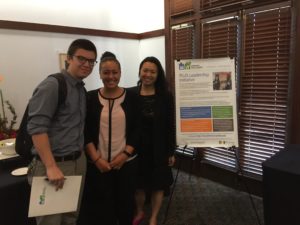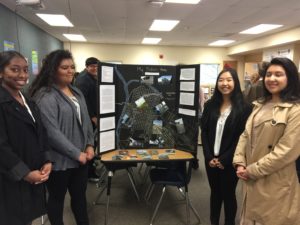Imagine that there’s a girl waking up in her San Francisco apartment. Dressed for school, this girl, Nadine, hustles to catch the first available MUNI bus — one that will take her to her school across town. She might more easily walk to her neighborhood school, but that’s literally falling apart, underperforming, and, while not segregated by policy, segregated in practice.
Because her single parent doesn’t have a car or the time between jobs to ferry her to and from school, a city bus is Nadine’s only option. And the bus ride takes an hour each way.
By the time Nadine gets to school, it’s likely too late to get the breakfast available for low-income students in the cafeteria. It’s too late to take part in any extra-curricular activities or take advantage of tutoring opportunities. In fact, frequently it’s too late to even catch the beginning of her first class, so she misses grade-wide assemblies and other community-building events. Nadine’s teachers might have to re-explain the day’s subjects to her, slowing down class for everyone and further ostracizing a girl who just wants and deserves a decent public education.
By the time Nadine gets home, it’s an hour after her peers have, and she’s missed participating in sports, internships, and other activities that colleges want to see on applications. She’s also lost an hour of homework time. Every day, Nadine falls another two hours behind simply because of where she lives. Not because she doesn’t have potential, or because she isn’t smart or driven, but because her family lives in the Bayview and not in Pacific Heights.
Now, multiply that scenario by all the children in all the socioeconomically disadvantaged neighborhoods in all the cities, and extrapolate that out over generations. It’s a shattering problem of access, opportunity, and privilege. But is it a problem for cities or a problem for schools?
Whose job is it to address this foundational element of ongoing inequity?
Looking Beyond Barriers
In 2006, The Walter & Elise Haas Fund began a long collaboration with the Center for Cities + Schools (CC+S), an organization created to address the siloed systems that separate cities from the public schools that serve them. Municipal busing systems, as one example, didn’t align with school districts’ needs because the cross-channel communication systems simply haven’t existed.
It wasn’t anyone’s job to make these helpful connections and so: no one took responsibility for it.
How Does Center for Cities + Schools Help?
Begun in 2004 as an interdisciplinary research initiative, Center for Cities + Schools applies scientific rigor to the problems cities and schools face together. Through programs, research, and analysis, CC+S promotes understanding between educators and urban policymakers to solve longstanding and otherwise ignored problems. It does this work in the Bay Area in a way that resonates nationally.
Center for Cities + Schools changes the way people think about how schools and communities interact. After 14 years of existence and growth, its efforts focus on three areas of work:
- High-quality, non-partisan policy research that leads to solutions in the grey area between education and urban policy. (One example would be “Beyond the Yellow Bus,” the report that informed the example with which this post began.)
- The PLUS leadership initiative, through which graduate students provide resource-poor school districts with research in order to nurture ongoing city-school collaboration and find cross-cutting, win-win solutions
- Y-PLAN (Youth – Plan, Learn, Act, Now!) programming, which strategically engages high school youth in contributing to city planning and social change
Education funding and policy are too often crisis-focused and reactive. In contrast, CC+S’s approach is proactive. It searches out solutions that will positively impact teachers and high-need student populations. In supporting collaboration between cities, communities, and schools, CC+S helps education systems and leaders build healthy, vibrant, and joyful cities and schools for all.
How Does This Connect to the Haas Sr. Fund?
When CC+S was first conceived, connecting cities and schools was an unusual concept that struggled to find support. The Haas Sr. Fund recognized the concept’s potential and provided a modest planning grant that helped CC+S explore how school district and city leaders might move from recognizing their disconnect to actually addressing it.

It’s one thing to understand that busing kids to schools around the city might be an incomplete solution to disparity in education. Developing a data-based, sustainable plan to address inadequacies and then building the momentum to enact that plan — that’s something at an entirely different scale of impact. For even if and when city leaders understand that they have to connect with public schools to improve the community, the question of “how” remained unanswered — until CC+S took on the task.
Along with Stuart Foundation, the Walter & Elise Haas Fund helped establish CC+S as an on-going independent non-profit based at the University of California, Berkeley. And that interdisciplinary investment spurred on a further $8 million in grants from across the philanthropic community, creating over 50 research reports on education in the Bay Area, and preparing over 100 current and future leaders, who then, in turn, have helped city and school leadership to identify and solve the problems with which — shockingly — frequently no one had been tasked.
And yes, in a nice bit of serendipity, one of the PLUS research fellows who worked on one of those reports back in CC+S’ early days was Jamie Allison, the Walter & Elise Haas Fund’s Executive Director. You couldn’t ask for a nicer illustration of how developing leadership resources helps build the momentum required for long-term, dramatic effect.
The Haas Sr. Fund supported the growth of an idea that continues to lead to systematic change. Working in collaboration with CC+S and many others, we’ve changed the narrative.
What’s Next?
In the next five years, the Center for Cities and Schools looks to double its impact by deepening its focus on the Bay Area. Understanding how students from one neighborhood get dispersed across numerous schools, for example, helps the whole community work together to engage in a more vibrant, healthy, and just development process — such as what’s happening right now with HOPE SF.

Ten years ago, in the Bayview, 150 kids bused across the city to 30 different schools. That was bad for community, the city, schools, and students. Today, with effort, we’re finding a way to change the paradigm. The solutions weren’t found in isolation, or through a single savior. The Fund and its collaborative partners found momentum together, through valued perspectives that see through boundaries and enable advances.
The Walter & Elise Haas Fund is committed to all of the above. We aren’t the largest funder, or performing the research, or running the schools — but we can help promising new ideas to flourish so that everyone can find access and enjoy opportunity. Center for Cities + Schools is just one of the grantees with whom we’re proud to work.

